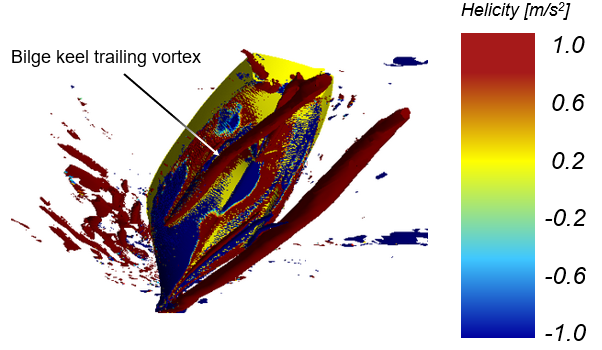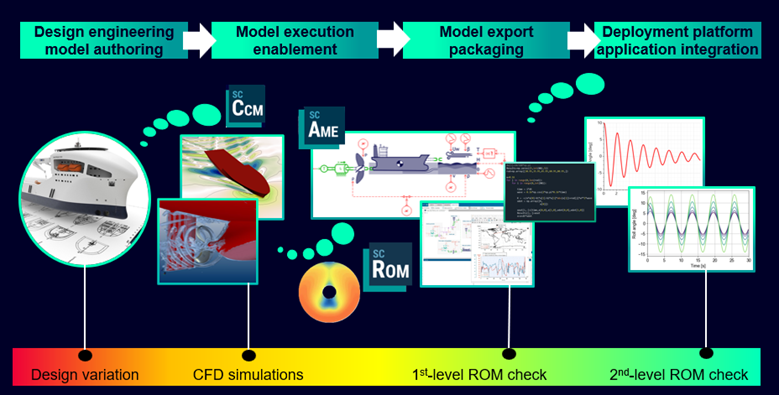Join the forum for Designers!
Your expertise is vital to the community. Join us and contribute your knowledge!
Join the Forum NowShare, learn and grow with the best professionals in the industry.
By Philipp Mucha

It’s another long day at ShipFive Design & Shipbuilding1. The design engineering team has gone through countless iterations to develop their latest innovation, retrofitting an older batch of successful offshore supply vessels.
A new bilge keel design was necessary after installing more energy-efficient azimuth pod drives and altering the skeg’s length for improved inflow to the new propulsion and steering device. Expensive model testing has shown that the vessel exhibits unfavorable roll motions in hard turns, and the team is growing frustrated.
They had a solution in mind to consolidate the conflicting requirements between all design parameters. They just needed final confirmation from CFD analysts that the new design bringing roll motions back to normal would not compromise propulsion performance.
Bad news. A colleague from the CFD department reports that for the latest design, a notable vortex is shed from the bilge keels at high drift angles during hard turning motions. The wake number in the inflow plane to the pods drops below the acceptable threshold. “Without the flow field data from CFD, we would not have caught this”, adds an engineer from the team.

“We are on the brink of running into major penalties if we don’t nail the design now”, he goes on to remark. Silence and despair fill the room. “We have three more months to zero in on the final design. If we don’t speed up the process of going through a new design iteration, we might only be able to look at one more design modification – if that”, another colleague says.
Enter reduced-order modeling (ROM) and the executable Digital Twin (xDT)
A member of the simulation team chimes in: “What if we can use a fast-time simulation model that gives us the right trends of responses, only to the key design variations?”. He goes on to explain: “We can define a ROM that addresses the most important physics of the problem. This will be some sort of coefficient-based system of equations where the coefficients represent the unique hydrodynamic properties of each design. Once we have the database of these coefficients, we can solve for the entire design envelope in minutes.”
The Chief Design Engineer sighs and answers: “We don’t have any budget left, much less time to wait for an open slot in the towing tank. That’s how we get the coefficients, correct?”
“Not quite. We can use our existing simulation tools and dynamically request and pay for resources as we use them in the cloud. There are no waiting times. We can start as we speak!”
“I am not convinced. How do we know if simulation outputs are accurate?”
The simulation engineer is confident: “We already validated our flow simulations based on the comparison of historic data from sea trials and the model testing for the failed designs. So, the tools are reliable.”
“You are making a good point. The real ship, once built, will be the physical asset to which we can connect the simulation infrastructure, and the real system and digital twin will feed off each other moving forward for as long as the vessel is in service. This will help us improve ship performance and refine the numerical tools emulating the ship.” The Chief Design Engineer starts to see the added value of this solution. “Not only could this path get us out of our immediate bind, but we might also embrace this digital twin concept moving forward just like you described.”
“Actually, it would be an executable digital twin. We will have to divide and conquer, identify the most critical domain problems and develop encapsulated models for them. The good news about this is that once we have a deployable application based on these encapsulated models, engineers who are not necessarily trained or experts in the engineering tools can also utilize these software packages, which will make us move faster as a shipyard. As you know best, our simulation group is small.”

What is an xDT?
The value proposition of the digital twin rests on the connectivity of the digital model to the physical asset. Measurements from operating the physical asset will be used to verify, validate and improve its digital twin, while the unmeasurable can be computed and analyzed using the digital twin. A bilateral stream of data and enhancements results from the inception of the design through the decommissioning of the physical asset. Van der Auweraer and Hartmann (2022) represent a primary reference for xDT. According to them, xDT can be defined as follows:
“When a dedicated encapsulation is extracted from the digital twin to model a specific set of behaviors in a specific context, delivering a standalone executable representation, such as an instantiated and self-contained model, is referred to as an executable digital twin.”
How the team at ShipFive Design & Shipbuilding can solve their design problem using ROM and build xDT for the future

The problem-solution concept is depicted in Figure 3. ShipFive Shipbuilding has deployed the Siemens digital thread at enterprise scale which facilitates the addition of the required ROM-based workflow and long-term xDT solution. Using Siemens NX geometry, modifications for the bilge keels are easily done on the already parameterized model. HEEDS workflow orchestrates the information and data exchange between all Simcenter tools.
The new geometry is then churned through the virtual towing tank pipeline in Simcenter STAR-CCM+, where a matrix of steady drift, yaw, planar motion mechanism (PMM), roll decay and forced roll oscillation tests are configured. The design engineering model authoring process is completed. The resulting databases of forces and moments on the ship, along with specific flow field information, are fed into a machine-learning (ML) data analysis block to populate the coefficient-based ROMs. These can conveniently be linked to in-house or Simcenter solutions like Simcenter Amesim ROM Builder. This is the model execution enablement phase. A first check is performed on the hydrodynamics performance of the vessel using the Simcenter Amesim marine library to ensure that no flawed design enters the stage in which the main objective of the troubleshooting iteration of the concept design is done – ensuring acceptable roll motion characteristics. These studies are run in the design team meetings on the deployment platform (a laptop or tablet).

1 Fictitious shipyard
Join the forum for Designers!
Your expertise is vital to the community. Join us and contribute your knowledge!
Join the Forum NowShare, learn and grow with the best professionals in the industry.

